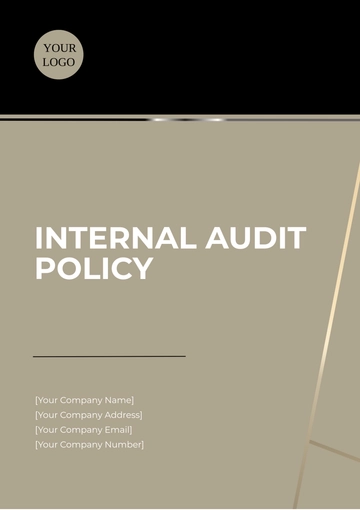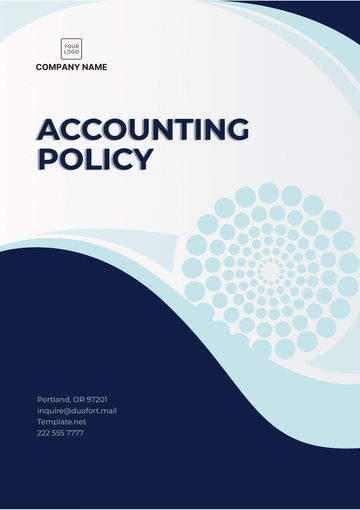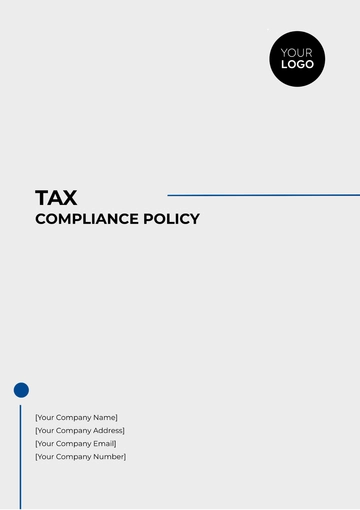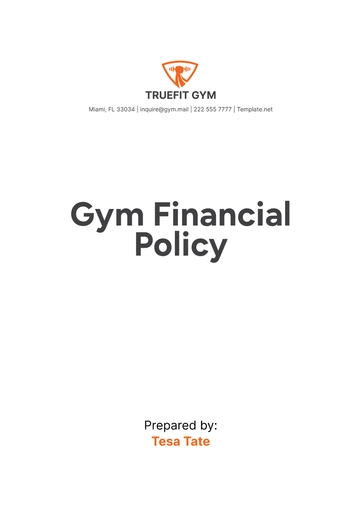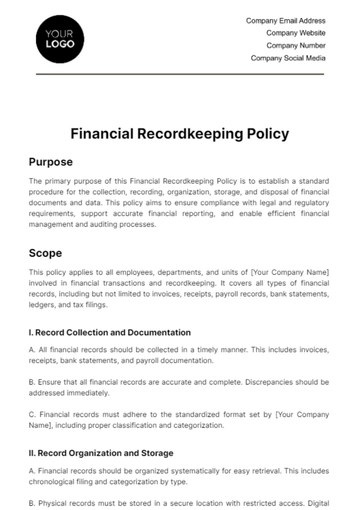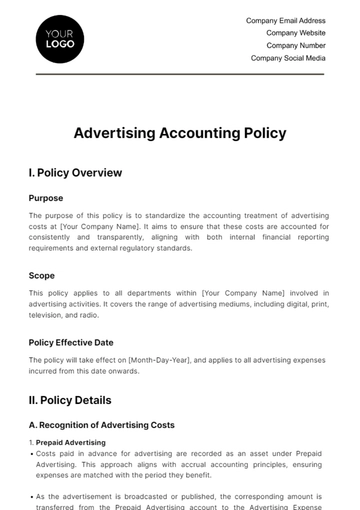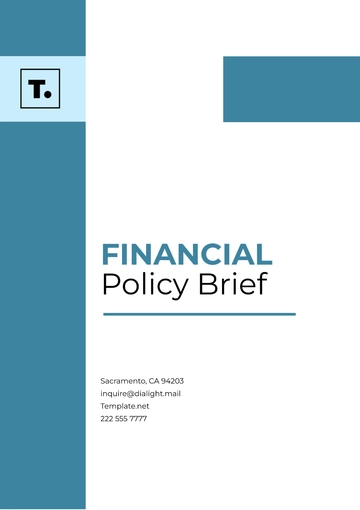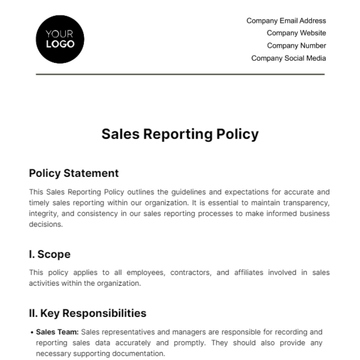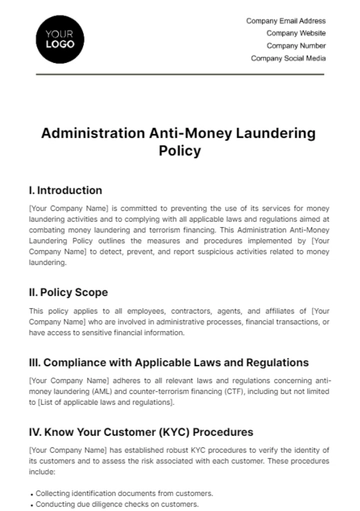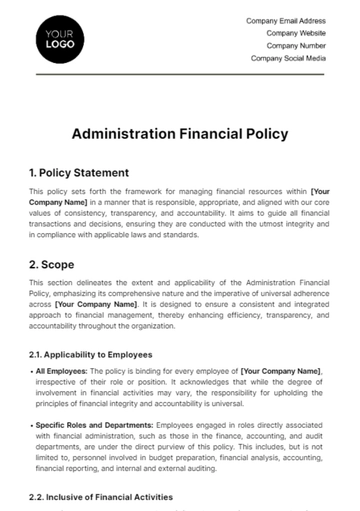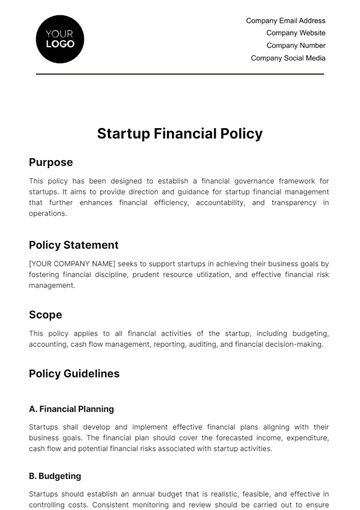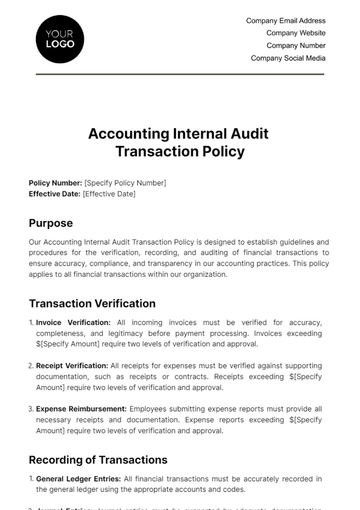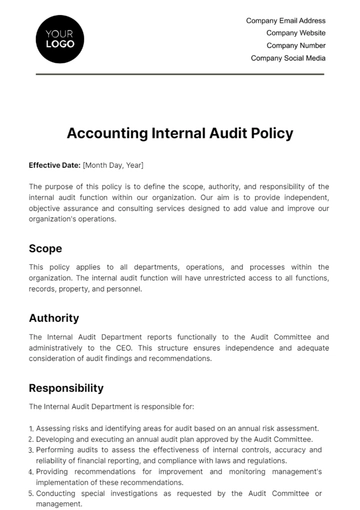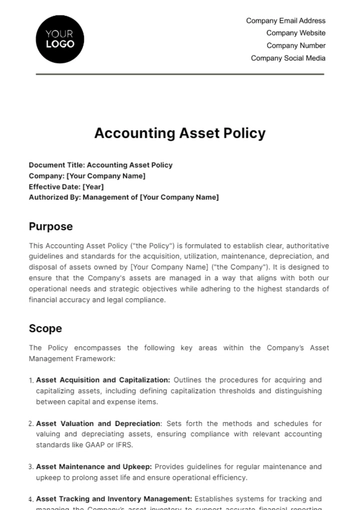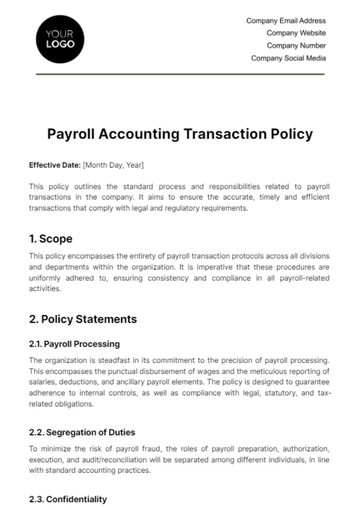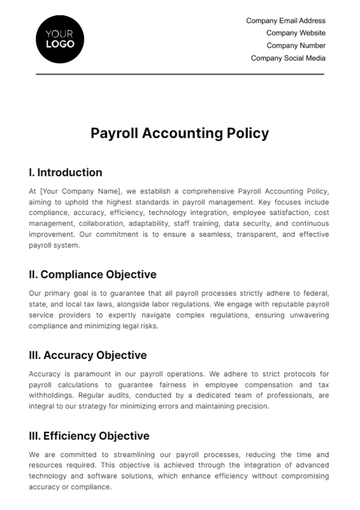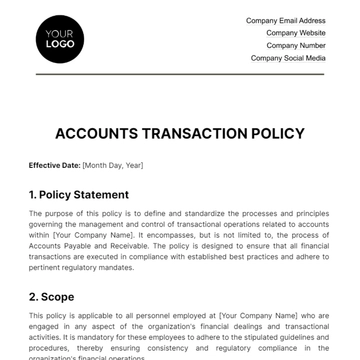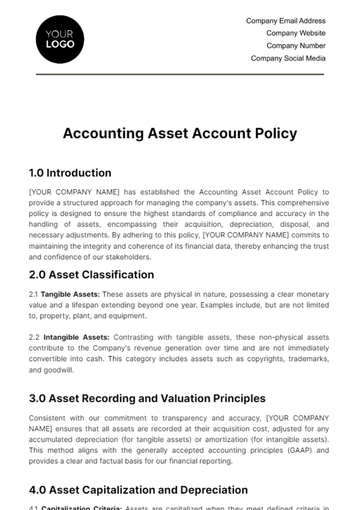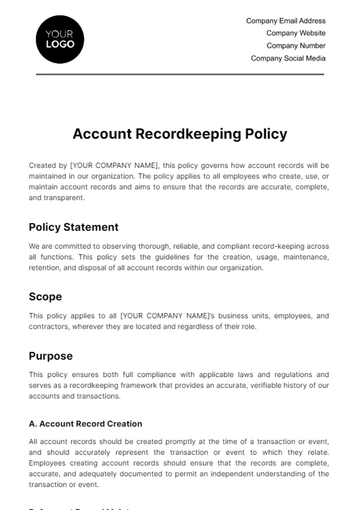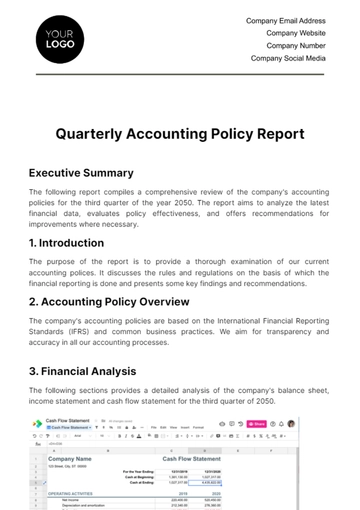Free Gym Financial Policy
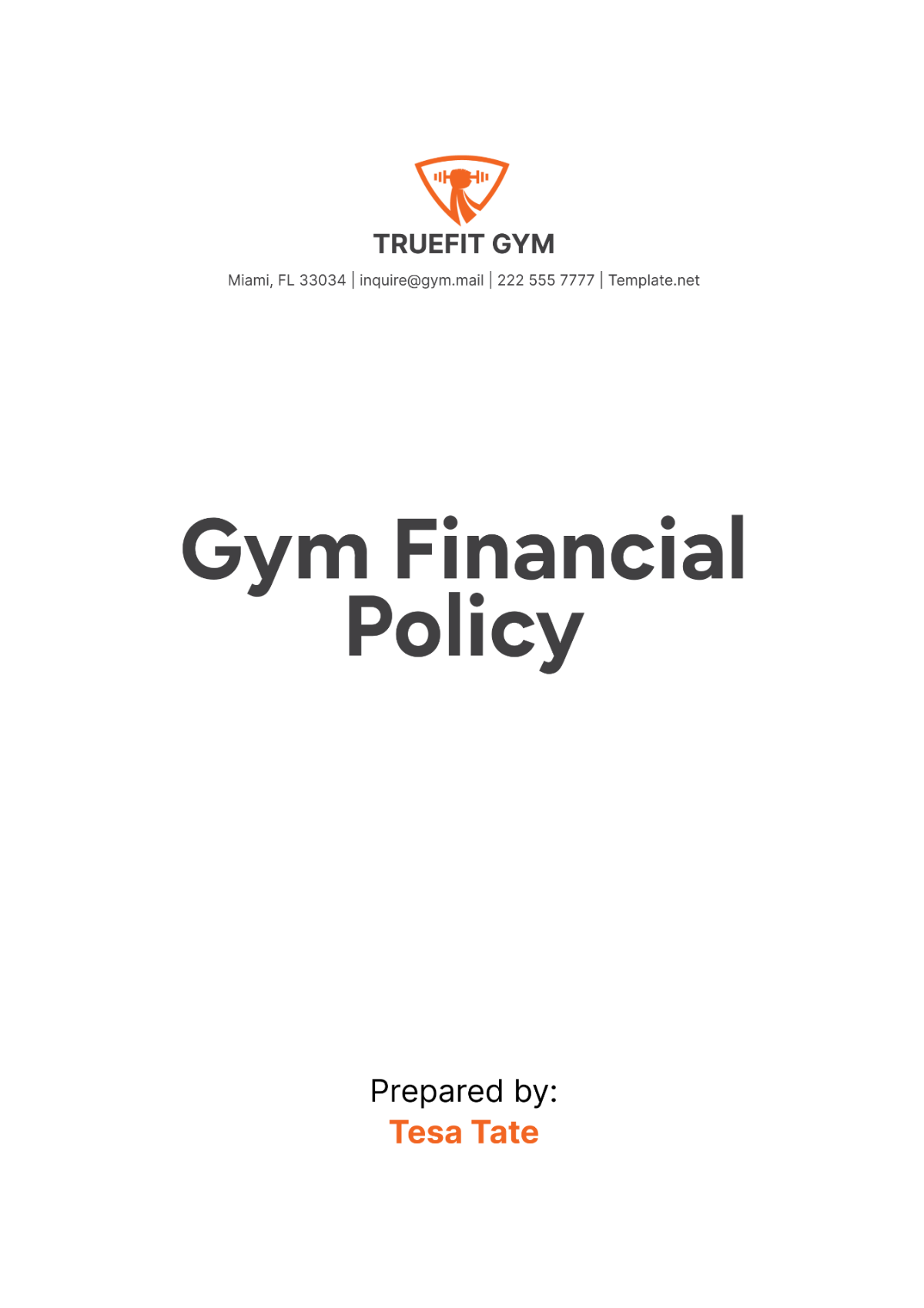
I. Introduction
This Financial Policy outlines the financial protocols, procedures, and regulations governing the operations of [Your Company Name]. The purpose of this policy is to ensure transparency, accountability, and effective financial management within the gym. By adhering to these guidelines, we aim to maintain financial stability, optimize resource allocation, and enhance overall operational efficiency.
A. Objectives
Financial Accountability: Establish clear financial responsibilities and accountability for all staff members involved in financial transactions and management.
Resource Optimization: Ensure optimal use of financial resources to support gym operations, maintenance, and development.
Transparency: Promote transparency in financial reporting and decision-making processes to build trust among stakeholders.
Regulatory Compliance: Adhere to all relevant financial regulations and standards to maintain compliance and avoid legal issues.
Financial Sustainability: Implement strategies to achieve long-term financial sustainability and growth for the gym.
B. Scope
Financial Transactions: Covers all transactions including income, expenses, and financial reporting.
Budgeting: Encompasses the preparation, approval, and monitoring of budgets.
Expense Management: Involves policies related to expense authorization, documentation, and reimbursement.
Revenue Management: Includes policies on membership fees, class fees, and other sources of revenue.
Audit and Compliance: Outlines procedures for financial audits and compliance checks.
C. Policy Review
Regular Review: The financial policy will be reviewed annually to ensure it remains relevant and effective.
Stakeholder Input: Solicit input from key stakeholders during the review process to incorporate diverse perspectives.
Updates and Amendments: Make necessary updates and amendments to the policy based on review findings and changes in regulations.
II. Financial Transactions
A. Income Management
The following table summarizes the key sources of income for [Your Company Name]:
Source of Income | Description | Frequency |
|---|---|---|
Membership Fees | Fees collected from gym members for membership | Monthly |
Class Fees | Fees charged for attending specific fitness classes | Per Class Session |
Personal Training Fees | Fees for one-on-one training sessions | Per Session |
Merchandise Sales | Income from selling gym-related merchandise | Ongoing |
Membership Fees: Collected monthly from gym members, these fees form the primary source of income. Regular collection ensures a steady cash flow, essential for covering operational costs and planning future investments.
Class Fees: Charged per class session, these fees provide additional income and support the variety of fitness classes offered. This income is crucial for maintaining diverse class offerings and compensating instructors adequately.
Personal Training Fees: Income from personal training sessions supports specialized training services. These fees allow for personalized fitness programs and attract members seeking individualized attention.
Merchandise Sales: Ongoing sales of gym-related merchandise contribute to overall income. This revenue stream helps promote the gym's brand and provides members with convenient access to fitness gear.
Effective management of these income sources is crucial for financial stability. Diversifying income streams and ensuring timely collection of fees can enhance the gym's financial health and support its growth objectives.
B. Expense Management
The following table outlines the key categories of expenses:
Expense Category | Description | Frequency |
|---|---|---|
Staff Salaries | Wages paid to gym staff | Bi-Weekly |
Equipment Maintenance | Costs for maintaining and repairing gym equipment | Monthly |
Utility Bills | Payments for electricity, water, and other utilities | Monthly |
Marketing Expenses | Costs for advertising and promotions | Quarterly |
Facility Upkeep | Costs for cleaning and maintaining the gym facility | Ongoing |
Staff Salaries: Paid bi-weekly, these wages are essential for retaining qualified staff. Competitive salaries ensure the gym attracts and maintains skilled professionals, which directly impacts service quality and member satisfaction.
Equipment Maintenance: Monthly maintenance costs are vital for keeping equipment in good working order. Regular maintenance prevents breakdowns, extends equipment lifespan, and ensures a safe workout environment.
Utility Bills: Monthly payments for utilities are necessary for gym operations. Efficient management of utility usage can reduce costs and support sustainability efforts.
Marketing Expenses: Quarterly marketing expenses help promote the gym and attract new members. Effective marketing strategies can increase membership and class attendance, boosting overall income.
Facility Upkeep: Ongoing costs for cleaning and maintenance are crucial for providing a pleasant and hygienic environment. A well-maintained facility enhances member experience and can lead to higher retention rates.
Managing expenses effectively is essential for maintaining financial health. Implementing cost-saving measures, such as energy-efficient practices and regular maintenance schedules, can help control expenses and improve profitability.
III. Budgeting
A. Budget Preparation
The following table showcases the steps involved in budget preparation:
No. | Step | Description |
|---|---|---|
1 | Establish Objectives | Define financial goals and objectives for the budget period |
2 | Gather Data | Collect financial data from previous periods and projections for the upcoming period |
3 | Draft Budget | Prepare a draft budget outlining expected income and expenses |
4 | Review and Revise | Review the draft budget with key stakeholders and make necessary revisions |
5 | Final Approval | Obtain final approval from the designated authority |
Establish Objectives: Defining financial goals ensures that the budget aligns with the gym's strategic priorities. Clear objectives provide a framework for allocating resources and setting financial targets.
Gather Data: Collecting financial data from past periods and projections helps in making informed decisions. This step involves analyzing trends, identifying patterns, and considering external factors that could impact the budget.
Draft Budget: Preparing a draft budget involves outlining expected income and expenses. This draft serves as a preliminary financial plan and includes detailed projections for each income source and expense category.
Review and Revise: Reviewing the draft budget with stakeholders allows for input and adjustments. This collaborative approach ensures the budget is realistic and comprehensive, addressing all key financial aspects.
Final Approval: Obtaining final approval from the designated authority formalizes the budget. This step ensures accountability and provides a clear financial roadmap for the upcoming period.
Budgeting is a critical financial management tool that helps in planning and controlling resources. A well-prepared budget provides a roadmap for achieving financial objectives and enables effective monitoring of financial performance. Regular reviews and updates ensure the budget remains relevant and responsive to changing circumstances.
B. Budget Monitoring
Monthly Reviews: Conduct monthly reviews of actual income and expenses against the budget. This regular monitoring helps identify variances early and allows for timely corrective actions.
Variance Analysis: Analyze significant variances between budgeted and actual figures. Understanding the reasons for variances helps in making informed adjustments and improving future budgeting accuracy.
Quarterly Reports: Prepare and distribute quarterly financial reports to key stakeholders. These reports provide an overview of financial performance and highlight any areas of concern or success.
Adjustments: Make necessary adjustments to the budget based on review findings. Flexibility in budgeting allows for responsive financial management and helps maintain alignment with objectives.
C. Long-Term Financial Planning
Forecasting: Develop long-term financial forecasts to anticipate future financial needs and opportunities. Accurate forecasting supports strategic planning and resource allocation.
Capital Planning: Plan for major capital expenditures, such as facility upgrades or new equipment purchases. This ensures that funds are available for significant investments that support growth and development.
Risk Management: Identify and assess financial risks, and develop strategies to mitigate them. Effective risk management protects the gym's financial health and ensures sustainability.
Financial Goals: Set long-term financial goals and establish a timeline for achieving them. Clear goals provide direction and motivation for financial planning and management.
IV. Revenue Management
A. Membership Fees
The following table presents the membership fee structure at [Your Company Name]:
Membership Type | Monthly Fee | Annual Fee | Benefits Included |
|---|---|---|---|
Basic | $30 | $300 | Access to gym facilities |
Premium | $50 | $500 | Access to gym facilities, classes, and one personal training session per month |
VIP | $80 | $800 | All Premium benefits plus unlimited personal training sessions and merchandise discounts |
Basic Membership: Priced at $30 per month or $300 annually, this membership provides access to gym facilities. It offers an affordable option for members who primarily use the gym for individual workouts.
Premium Membership: At $50 per month or $500 annually, this membership includes access to gym facilities, classes, and one personal training session per month. The additional benefits provide greater value and attract members seeking a more comprehensive fitness experience.
VIP Membership: With a fee of $80 per month or $800 annually, the VIP membership offers all Premium benefits plus unlimited personal training sessions and merchandise discounts. This membership targets members looking for extensive personalized support and additional perks.
Offering a tiered membership structure caters to diverse member needs and preferences. Regularly reviewing and adjusting membership fees and benefits ensures they remain competitive and aligned with market trends.
B. Class Fees
Single Class Fees: Fees charged per individual class session. This provides flexibility for members who prefer pay-as-you-go options.
Class Packages: Discounted rates for purchasing multiple class sessions upfront. This encourages members to commit to regular attendance and provides predictable income.
Specialty Classes: Higher fees for specialty classes such as yoga workshops or advanced training sessions. These classes cater to specific interests and can generate additional revenue.
Member Discounts: Offering discounts on class fees for members promotes class participation and adds value to memberships.
C. Personal Training Fees
Single Session Fees: Fees charged for individual personal training sessions. This allows members to access personalized training on a per-session basis.
Training Packages: Discounted rates for purchasing multiple training sessions upfront. This encourages long-term commitment and provides consistent income.
Specialized Programs: Higher fees for specialized training programs such as weight loss boot camps or sports-specific training. These programs cater to targeted fitness goals and attract specific member demographics.
Trainer Expertise: Fees may vary based on trainer expertise and qualifications. Higher fees for experienced trainers reflect their advanced skills and knowledge.
V. Expense Authorization
A. Authorization Levels
The following table outlines the expense authorization levels at [Your Company Name]:
Position | Authorization Limit | Approval Required From |
|---|---|---|
Front Desk Staff | Up to $100 | Supervisor |
Department Managers | Up to $1,000 | General Manager |
General Manager | Up to $10,000 | Executive Director |
Executive Director | Over $10,000 | Board of Directors |
Front Desk Staff: Authorized to approve expenses up to $100, typically for minor operational needs. This level of authorization allows for prompt handling of small-scale purchases without delays.
Department Managers: Can approve expenses up to $1,000, covering routine departmental expenses. This authorization level ensures that managers have the flexibility to manage their departments effectively.
General Manager: Authorized to approve expenses up to $10,000, enabling the management of larger operational costs. This level of authorization supports significant purchases and investments necessary for gym operations.
Executive Director: Can approve expenses over $10,000, typically for major investments and strategic initiatives. This ensures that high-value expenditures are carefully considered and aligned with organizational goals.
Establishing clear authorization levels enhances financial control and accountability. Each level of authorization ensures that expenditures are reviewed and approved by the appropriate personnel, preventing unauthorized or unnecessary spending.
B. Expense Documentation
Receipts and Invoices: All expenses must be supported by original receipts or invoices. Proper documentation ensures transparency and accountability in financial transactions.
Expense Reports: Employees must submit detailed expense reports for all authorized expenditures. These reports provide a comprehensive record of spending and facilitate accurate financial tracking.
Approval Signatures: Expense reports and supporting documents must be signed by the authorized approver. Approval signatures verify that expenses have been reviewed and approved by the designated authority.
Audit Trail: Maintain an audit trail of all expenses, including digital records. An audit trail ensures that all financial transactions can be traced and reviewed if necessary.
C. Reimbursement Process
Submission Timeline: Employees must submit reimbursement requests within 30 days of incurring the expense. Timely submission ensures that reimbursements are processed promptly and financial records are up-to-date.
Review and Approval: Reimbursement requests are reviewed and approved by the designated authority. This review process verifies that expenses are legitimate and within policy guidelines.
Payment Processing: Approved reimbursements are processed and paid within 15 days. Prompt payment supports employee satisfaction and financial accuracy.
Record Keeping: All reimbursement records are maintained for a minimum of five years. Proper record keeping ensures compliance with financial regulations and supports future audits.
VI. Financial Reporting
A. Monthly Financial Statements
The following table presents the key components of monthly financial statements:
Component | Description |
|---|---|
Income Statement | Summary of income and expenses for the month |
Balance Sheet | Snapshot of assets, liabilities, and equity |
Cash Flow Statement | Overview of cash inflows and outflows |
Budget Variance Report | Comparison of actual figures to budgeted figures |
Income Statement: Provides a summary of the gym's income and expenses for the month. This statement helps track financial performance and identify trends or areas of concern.
Balance Sheet: Presents a snapshot of the gym's financial position, including assets, liabilities, and equity. This report provides insight into the gym's financial health and stability.
Cash Flow Statement: Offers an overview of cash inflows and outflows, highlighting the gym's liquidity. Understanding cash flow is crucial for managing day-to-day operations and planning future investments.
Budget Variance Report: Compares actual financial figures to budgeted amounts, identifying variances. Analyzing variances helps in understanding deviations from the plan and making necessary adjustments.
Regular financial reporting is essential for effective financial management. Monthly financial statements provide a comprehensive view of the gym's financial performance, supporting informed decision-making and strategic planning.
B. Quarterly Financial Reports
Comprehensive Overview: Quarterly financial reports provide a broader view of financial performance, combining monthly data. These reports help identify longer-term trends and assess progress towards financial goals.
Stakeholder Communication: Distribute quarterly reports to key stakeholders, including board members and investors. Transparent communication builds trust and ensures that stakeholders are informed about financial performance.
Performance Analysis: Conduct a detailed analysis of financial performance for the quarter. This analysis helps identify strengths and weaknesses, guiding future financial planning and management.
Strategic Adjustments: Use insights from quarterly reports to make strategic adjustments. Regular assessment and adaptation support financial stability and growth.
C. Annual Financial Report
Year-End Summary: The annual financial report provides a comprehensive summary of the gym's financial performance for the year. This report includes detailed income statements, balance sheets, and cash flow statements.
Audit and Review: Conduct an annual audit to verify the accuracy and integrity of financial records. An independent review ensures compliance with financial regulations and standards.
Strategic Planning: Use the annual financial report to inform strategic planning for the upcoming year. This report provides valuable insights for setting financial goals and priorities.
Stakeholder Presentation: Present the annual financial report to stakeholders, including board members and investors. This presentation highlights key achievements and challenges, fostering transparency and accountability.
VII. Cash Handling Procedures
A. Cash Collection
The following table summarizes the cash collection process:
No. | Step | Description |
|---|---|---|
1 | Cash Receipt | Record cash received at the point of sale |
2 | Daily Reconciliation | Reconcile cash receipts with sales records daily |
3 | Secure Storage | Store collected cash in a secure location |
4 | Bank Deposits | Deposit cash in the bank regularly |
Cash Receipt: Recording cash received at the point of sale ensures accurate tracking of income. This step is crucial for maintaining financial integrity and preventing discrepancies.
Daily Reconciliation: Reconciling cash receipts with sales records daily helps identify and resolve any discrepancies promptly. Regular reconciliation ensures accurate financial records and supports financial accountability.
Secure Storage: Storing collected cash in a secure location prevents theft and loss. Secure storage is essential for protecting financial assets and maintaining operational security.
Bank Deposits: Regularly depositing cash in the bank reduces the risk of loss and ensures that funds are available for operational needs. Timely bank deposits support financial management and liquidity.
Implementing robust cash handling procedures is essential for financial security. Clear steps for cash collection, reconciliation, and storage prevent discrepancies and protect financial assets. Regular training for staff on cash handling protocols can further enhance security and compliance.
B. Cash Disbursements
Authorized Payments: Ensure that all cash disbursements are authorized by the appropriate personnel. Authorization prevents unauthorized spending and ensures financial control.
Documentation: Maintain detailed documentation for all cash disbursements. Proper documentation supports transparency and accountability in financial transactions.
Petty Cash Management: Establish clear guidelines for managing petty cash. Regularly reconcile petty cash accounts to ensure accuracy and prevent misuse.
Expense Tracking: Track all cash disbursements accurately to maintain comprehensive financial records. Accurate tracking supports financial reporting and auditing.
C. Bank Reconciliation
Monthly Reconciliation: Perform bank reconciliation monthly to compare bank statements with financial records. Regular reconciliation ensures accuracy and identifies any discrepancies promptly.
Discrepancy Resolution: Investigate and resolve any discrepancies identified during reconciliation. Timely resolution prevents financial issues and maintains accurate records.
Reconciliation Documentation: Maintain detailed documentation of the reconciliation process. Proper documentation supports financial audits and compliance checks.
Continuous Monitoring: Continuously monitor bank transactions to ensure accuracy and prevent fraud. Regular monitoring supports financial security and integrity.
VIII. Internal Controls
A. Segregation of Duties
The following table outlines the segregation of duties at [Your Company Name]:
Function | Role(s) Involved | Description |
|---|---|---|
Cash Handling | Cashier, Supervisor | Separate cash collection and reconciliation |
Expense Approval | Department Manager, General Manager | Separate expense authorization and payment |
Financial Reporting | Accountant, Financial Analyst | Separate financial reporting and review |
Audit and Compliance | Internal Auditor, External Auditor | Separate audit functions from operational roles |
Cash Handling: Involving both the cashier and supervisor in cash handling ensures that no single person is responsible for the entire process. This separation of duties reduces the risk of errors and fraud.
Expense Approval: Separating expense authorization and payment responsibilities between the department manager and general manager provides a system of checks and balances. This segregation ensures that expenses are reviewed and approved by different personnel.
Financial Reporting: Involving both an accountant and financial analyst in financial reporting ensures accuracy and thorough review. This separation allows for independent verification of financial data.
Audit and Compliance: Separating audit functions from operational roles, with both internal and external auditors, ensures unbiased review and compliance with financial standards. This segregation enhances the integrity of financial audits.
Implementing robust internal controls through segregation of duties enhances financial security and accountability. By distributing financial responsibilities among multiple personnel, the risk of errors, fraud, and unauthorized transactions is significantly reduced.
B. Internal Audits
Audit Schedule: Establish a regular schedule for internal audits to review financial processes and records. Regular audits ensure ongoing compliance and identify areas for improvement.
Audit Procedures: Develop comprehensive audit procedures to guide the audit process. Detailed procedures ensure thorough and consistent review of financial activities.
Audit Reporting: Prepare detailed audit reports outlining findings and recommendations. Clear reporting supports transparency and guides corrective actions.
Corrective Actions: Implement corrective actions based on audit findings to address any issues. Prompt action ensures continuous improvement and compliance with financial standards.
C. Fraud Prevention
Fraud Awareness: Provide regular training on fraud prevention and detection for all staff. Awareness training helps employees recognize and report potential fraud.
Whistleblower Policy: Establish a whistleblower policy to encourage reporting of suspicious activities. A clear policy protects whistleblowers and supports fraud detection.
Monitoring and Detection: Implement systems for continuous monitoring and detection of fraudulent activities. Regular monitoring helps identify and address issues promptly.
Response Plan: Develop a response plan for addressing detected fraud. A clear plan ensures that fraud is handled effectively and minimizes impact.
IX. Continuous Improvement
A. Policy Review and Updates
Schedule Reviews: Setting a regular schedule for policy reviews ensures that the financial policy remains up-to-date and relevant. Regular reviews help identify and address any gaps or outdated procedures.
Gather Feedback: Collecting feedback from stakeholders provides valuable insights into the effectiveness of the policy. Stakeholder input helps ensure that the policy addresses the needs and concerns of those affected.
Draft Revisions: Preparing draft revisions based on feedback and analysis allows for careful consideration of potential changes. Draft revisions provide a basis for discussion and further refinement.
Review and Approval: Reviewing draft revisions with key stakeholders ensures that proposed changes are thoroughly evaluated. Obtaining approval formalizes the changes and ensures stakeholder buy-in.
Implement Changes: Implementing approved changes and communicating them to all staff ensures that the updated policy is effectively integrated into operations. Clear communication supports compliance and understanding of the new procedures.
B. Training and Development
Ongoing Training: Providing ongoing training for staff on financial policies and procedures. Regular training ensures that all employees are knowledgeable and compliant with financial protocols.
Skill Development: Investing in skill development for financial management staff. Enhancing skills supports better financial decision-making and management.
New Policy Orientation: Conducting orientation sessions for new employees on financial policies. Proper orientation ensures that new staff understand and follow financial procedures from the start.
Professional Development: Encouraging professional development opportunities for financial staff. Continuous learning supports career growth and enhances financial expertise.
Continuous improvement is crucial for maintaining the effectiveness of the Financial Policy. By regularly evaluating the policy, implementing updates, and providing training, [Your Company Name] ensures that the policy remains relevant and effective in supporting the gym's financial management practices.
- 100% Customizable, free editor
- Access 1 Million+ Templates, photo’s & graphics
- Download or share as a template
- Click and replace photos, graphics, text, backgrounds
- Resize, crop, AI write & more
- Access advanced editor
Set clear financial guidelines with the Gym Financial Policy Template! This template, available on Template.net, is designed to be customizable to meet your gym’s management needs. Its editable format allows for easy personalization. Use the AI Editor Tool to create a detailed and precise financial policy, ensuring effective financial management!
You may also like
- HR Policy
- Restaurant Policy
- Company Policy
- Accounting Policies and Procedures
- Website Policy
- Privacy Policy
- Safety Policy
- School Policy
- IT and Software Policy
- Law Firm Policy
- Construction Policy
- Interior Design Policy
- Travel Agency Policy
- Education Academic Policy
- Security Policy
- Real Estate Policy
- Expense Policy
- Software Policy

